[English] 日本語
 Yorodumi
Yorodumi- PDB-6frk: Structure of a prehandover mammalian ribosomal SRP and SRP recept... -
+ Open data
Open data
- Basic information
Basic information
| Entry | Database: PDB / ID: 6frk | ||||||||||||||||||||||||||||||||||||||||||||||||
|---|---|---|---|---|---|---|---|---|---|---|---|---|---|---|---|---|---|---|---|---|---|---|---|---|---|---|---|---|---|---|---|---|---|---|---|---|---|---|---|---|---|---|---|---|---|---|---|---|---|
| Title | Structure of a prehandover mammalian ribosomal SRP and SRP receptor targeting complex | ||||||||||||||||||||||||||||||||||||||||||||||||
 Components Components |
| ||||||||||||||||||||||||||||||||||||||||||||||||
 Keywords Keywords | TRANSLATION / ER membrane targeting ribosome Signal recognition particle | ||||||||||||||||||||||||||||||||||||||||||||||||
| Function / homology |  Function and homology information Function and homology informationSRP-dependent cotranslational protein targeting to membrane / signal recognition particle receptor complex / SRP-dependent cotranslational protein targeting to membrane, signal sequence recognition / endoplasmic reticulum signal peptide binding / signal recognition particle, endoplasmic reticulum targeting / signal recognition particle binding / granulocyte differentiation / protein targeting to ER / signal-recognition-particle GTPase / protein localization to Golgi apparatus ...SRP-dependent cotranslational protein targeting to membrane / signal recognition particle receptor complex / SRP-dependent cotranslational protein targeting to membrane, signal sequence recognition / endoplasmic reticulum signal peptide binding / signal recognition particle, endoplasmic reticulum targeting / signal recognition particle binding / granulocyte differentiation / protein targeting to ER / signal-recognition-particle GTPase / protein localization to Golgi apparatus / negative regulation of translational elongation / SRP-dependent cotranslational protein targeting to membrane, translocation / 7S RNA binding / SRP-dependent cotranslational protein targeting to membrane / Golgi to plasma membrane protein transport / exocrine pancreas development / TPR domain binding / ribonucleoprotein complex binding / cytoplasmic microtubule / neutrophil chemotaxis / intracellular protein transport / GDP binding / ribosome binding / nuclear speck / GTPase activity / endoplasmic reticulum membrane / GTP binding / nucleolus / endoplasmic reticulum / Golgi apparatus / ATP hydrolysis activity / nucleoplasm / nucleus / cytosol Similarity search - Function | ||||||||||||||||||||||||||||||||||||||||||||||||
| Biological species |    | ||||||||||||||||||||||||||||||||||||||||||||||||
| Method | ELECTRON MICROSCOPY / single particle reconstruction / cryo EM / Resolution: 3.7 Å | ||||||||||||||||||||||||||||||||||||||||||||||||
 Authors Authors | Kobayashi, K. / Jomaa, A. / Ban, N. | ||||||||||||||||||||||||||||||||||||||||||||||||
| Funding support |  Switzerland, 2items Switzerland, 2items
| ||||||||||||||||||||||||||||||||||||||||||||||||
 Citation Citation |  Journal: Science / Year: 2018 Journal: Science / Year: 2018Title: Structure of a prehandover mammalian ribosomal SRP·SRP receptor targeting complex. Authors: Kan Kobayashi / Ahmad Jomaa / Jae Ho Lee / Sowmya Chandrasekar / Daniel Boehringer / Shu-Ou Shan / Nenad Ban /   Abstract: Signal recognition particle (SRP) targets proteins to the endoplasmic reticulum (ER). SRP recognizes the ribosome synthesizing a signal sequence and delivers it to the SRP receptor (SR) on the ER ...Signal recognition particle (SRP) targets proteins to the endoplasmic reticulum (ER). SRP recognizes the ribosome synthesizing a signal sequence and delivers it to the SRP receptor (SR) on the ER membrane followed by the transfer of the signal sequence to the translocon. Here, we present the cryo-electron microscopy structure of the mammalian translating ribosome in complex with SRP and SR in a conformation preceding signal sequence handover. The structure visualizes all eukaryotic-specific SRP and SR proteins and reveals their roles in stabilizing this conformation by forming a large protein assembly at the distal site of SRP RNA. We provide biochemical evidence that the guanosine triphosphate hydrolysis of SRP·SR is delayed at this stage, possibly to provide a time window for signal sequence handover to the translocon. | ||||||||||||||||||||||||||||||||||||||||||||||||
| History |
|
- Structure visualization
Structure visualization
| Movie |
 Movie viewer Movie viewer |
|---|---|
| Structure viewer | Molecule:  Molmil Molmil Jmol/JSmol Jmol/JSmol |
- Downloads & links
Downloads & links
- Download
Download
| PDBx/mmCIF format |  6frk.cif.gz 6frk.cif.gz | 4 MB | Display |  PDBx/mmCIF format PDBx/mmCIF format |
|---|---|---|---|---|
| PDB format |  pdb6frk.ent.gz pdb6frk.ent.gz | Display |  PDB format PDB format | |
| PDBx/mmJSON format |  6frk.json.gz 6frk.json.gz | Tree view |  PDBx/mmJSON format PDBx/mmJSON format | |
| Others |  Other downloads Other downloads |
-Validation report
| Summary document |  6frk_validation.pdf.gz 6frk_validation.pdf.gz | 2.3 MB | Display |  wwPDB validaton report wwPDB validaton report |
|---|---|---|---|---|
| Full document |  6frk_full_validation.pdf.gz 6frk_full_validation.pdf.gz | 2.7 MB | Display | |
| Data in XML |  6frk_validation.xml.gz 6frk_validation.xml.gz | 324.6 KB | Display | |
| Data in CIF |  6frk_validation.cif.gz 6frk_validation.cif.gz | 529.8 KB | Display | |
| Arichive directory |  https://data.pdbj.org/pub/pdb/validation_reports/fr/6frk https://data.pdbj.org/pub/pdb/validation_reports/fr/6frk ftp://data.pdbj.org/pub/pdb/validation_reports/fr/6frk ftp://data.pdbj.org/pub/pdb/validation_reports/fr/6frk | HTTPS FTP |
-Related structure data
| Related structure data |  4300MC M: map data used to model this data C: citing same article ( |
|---|---|
| Similar structure data |
- Links
Links
- Assembly
Assembly
| Deposited unit | 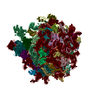
|
|---|---|
| 1 |
|
- Components
Components
-RNA chain , 5 types, 5 molecules 12578
| #1: RNA chain | Mass: 96826.289 Da / Num. of mol.: 1 / Source method: isolated from a natural source / Source: (natural)  |
|---|---|
| #2: RNA chain | Mass: 24437.535 Da / Num. of mol.: 1 / Source method: isolated from a natural source / Source: (natural)  |
| #5: RNA chain | Mass: 1185357.625 Da / Num. of mol.: 1 / Source method: isolated from a natural source / Source: (natural)  |
| #7: RNA chain | Mass: 38691.914 Da / Num. of mol.: 1 / Source method: isolated from a natural source / Source: (natural)  |
| #8: RNA chain | Mass: 50143.648 Da / Num. of mol.: 1 / Source method: isolated from a natural source / Source: (natural)  |
+Ribosomal protein ... , 41 types, 41 molecules 34ABCDEFGHIJLMNOPQRSTUVWXYacde...
-60S ribosomal protein ... , 2 types, 2 molecules Zb
| #33: Protein | Mass: 15704.635 Da / Num. of mol.: 1 / Source method: isolated from a natural source / Source: (natural)  |
|---|---|
| #35: Protein | Mass: 8722.283 Da / Num. of mol.: 1 / Source method: isolated from a natural source / Source: (natural)  |
-Signal recognition particle ... , 6 types, 6 molecules qruwxz
| #50: Protein | Mass: 12159.153 Da / Num. of mol.: 1 / Source method: isolated from a natural source / Source: (natural)  |
|---|---|
| #51: Protein | Mass: 67314.922 Da / Num. of mol.: 1 / Source method: isolated from a natural source / Source: (natural)  |
| #53: Protein | Mass: 65569.984 Da / Num. of mol.: 1 / Source method: isolated from a natural source / Source: (natural)  |
| #55: Protein | Mass: 8694.115 Da / Num. of mol.: 1 / Source method: isolated from a natural source / Source: (natural)  |
| #56: Protein | Mass: 55775.672 Da / Num. of mol.: 1 / Source method: isolated from a natural source / Source: (natural)  |
| #58: Protein | Mass: 12512.716 Da / Num. of mol.: 1 / Source method: isolated from a natural source / Source: (natural)  |
-SRP receptor ... , 2 types, 2 molecules vy
| #54: Protein | Mass: 23588.018 Da / Num. of mol.: 1 Source method: isolated from a genetically manipulated source Source: (gene. exp.)   |
|---|---|
| #57: Protein | Mass: 72232.578 Da / Num. of mol.: 1 Source method: isolated from a genetically manipulated source Source: (gene. exp.)   |
-Protein / Protein/peptide , 2 types, 2 molecules 6t
| #52: Protein/peptide | Mass: 1262.751 Da / Num. of mol.: 1 Source method: isolated from a genetically manipulated source Source: (gene. exp.)  Production host:  |
|---|---|
| #6: Protein | Mass: 22217.840 Da / Num. of mol.: 1 / Source method: isolated from a natural source / Source: (natural)  |
-Non-polymers , 4 types, 139 molecules 


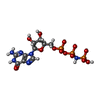



| #59: Chemical | ChemComp-MG / #60: Chemical | #61: Chemical | ChemComp-GTP / | #62: Chemical | |
|---|
-Details
| Has protein modification | N |
|---|
-Experimental details
-Experiment
| Experiment | Method: ELECTRON MICROSCOPY |
|---|---|
| EM experiment | Aggregation state: PARTICLE / 3D reconstruction method: single particle reconstruction |
- Sample preparation
Sample preparation
| Component |
| ||||||||||||||||||||||||||||||||||||
|---|---|---|---|---|---|---|---|---|---|---|---|---|---|---|---|---|---|---|---|---|---|---|---|---|---|---|---|---|---|---|---|---|---|---|---|---|---|
| Source (natural) |
| ||||||||||||||||||||||||||||||||||||
| Source (recombinant) |
| ||||||||||||||||||||||||||||||||||||
| Buffer solution | pH: 7.6 | ||||||||||||||||||||||||||||||||||||
| Specimen | Embedding applied: NO / Shadowing applied: NO / Staining applied: NO / Vitrification applied: YES | ||||||||||||||||||||||||||||||||||||
| Specimen support | Grid material: COPPER / Grid type: Quantifoil R2/2 | ||||||||||||||||||||||||||||||||||||
| Vitrification | Instrument: FEI VITROBOT MARK IV / Cryogen name: ETHANE-PROPANE / Humidity: 100 % / Chamber temperature: 277 K |
- Electron microscopy imaging
Electron microscopy imaging
| Experimental equipment |  Model: Titan Krios / Image courtesy: FEI Company |
|---|---|
| Microscopy | Model: FEI TITAN KRIOS |
| Electron gun | Electron source:  FIELD EMISSION GUN / Accelerating voltage: 300 kV / Illumination mode: FLOOD BEAM FIELD EMISSION GUN / Accelerating voltage: 300 kV / Illumination mode: FLOOD BEAM |
| Electron lens | Mode: BRIGHT FIELD / Nominal magnification: 59000 X / Cs: 2.7 mm |
| Specimen holder | Specimen holder model: FEI TITAN KRIOS AUTOGRID HOLDER |
| Image recording | Electron dose: 40 e/Å2 / Detector mode: INTEGRATING / Film or detector model: FEI FALCON II (4k x 4k) |
- Processing
Processing
| EM software |
| ||||||||||||
|---|---|---|---|---|---|---|---|---|---|---|---|---|---|
| CTF correction | Type: PHASE FLIPPING AND AMPLITUDE CORRECTION | ||||||||||||
| 3D reconstruction | Resolution: 3.7 Å / Resolution method: FSC 0.143 CUT-OFF / Num. of particles: 45800 / Symmetry type: POINT | ||||||||||||
| Atomic model building | Protocol: RIGID BODY FIT / Space: RECIPROCAL |
 Movie
Movie Controller
Controller



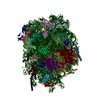

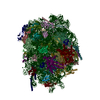



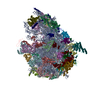
 PDBj
PDBj





































